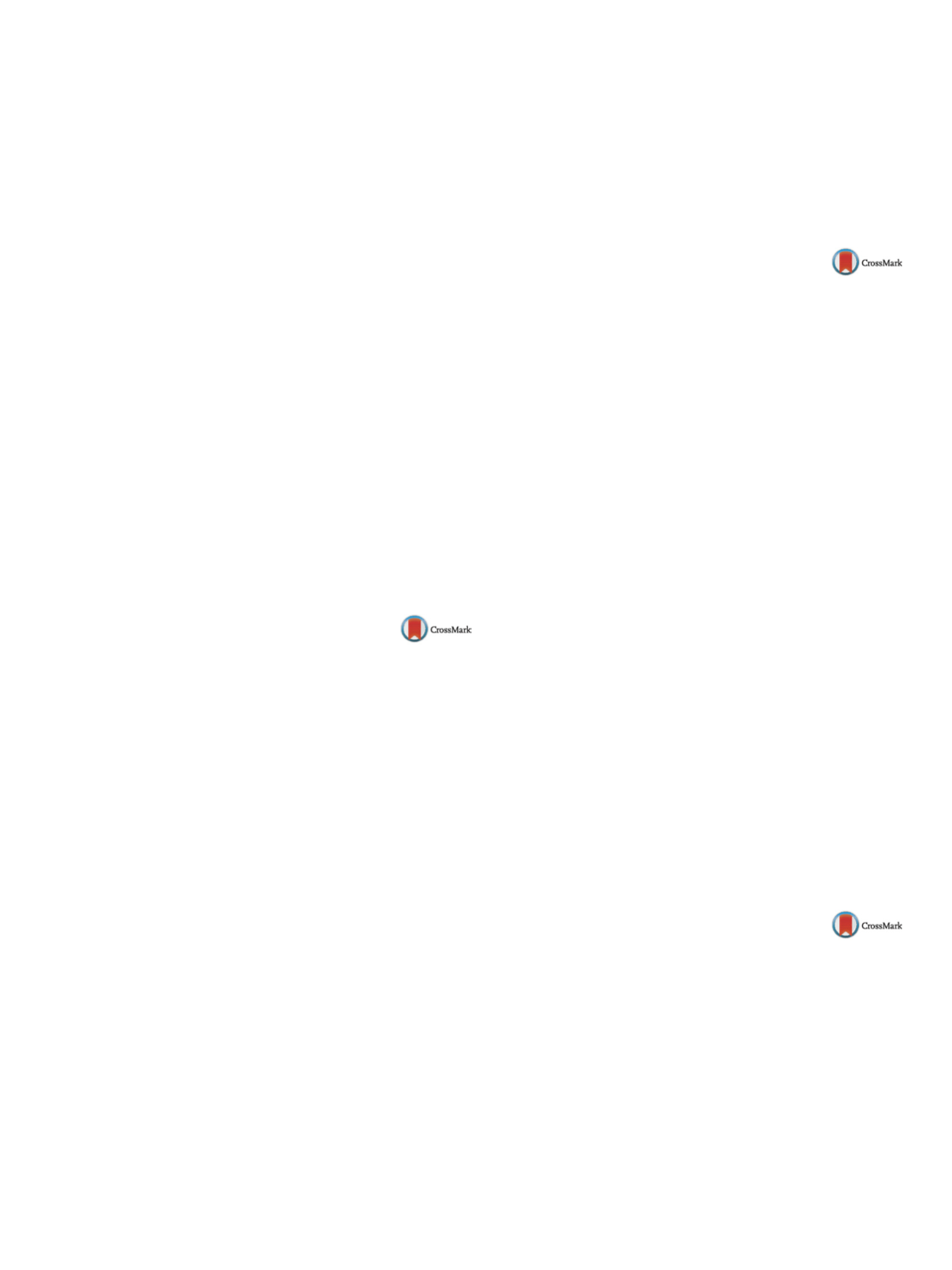

25th European Congress of Psychiatry / European Psychiatry 41S (2017) S847–S910
S875
class present have emerged recently, are frequently bought using
the internet and have similar effects to other hallucinogenic drugs;
however, they may pose larger risks, due to the limited knowl-
edge about them, their relatively low price and availability via the
internet
[1–3] .The purpose of this report is to review the clini-
cal evidence for the potential of abuse of NBOMe compounds. We
propose a case report and literature review.
Method
We conducted a systematic review of the literature with
the principal database (PubMed, Enbase, PsychInfo) andwe present
a case report.
Results
The effects of 25C-NBOMe is characterized by hallucina-
tion, violent agitation, rhabdomyolysis and kydney injury.
Discussion and conclusion
Effects from 25C-NBOMe in our case
report were similar to previous individual case reports in litera-
ture
[2,3] .The clinical features were also similar to effects from
other analogues in the class (25I-NBOMe, 25B-NBOMe). In our case,
violent agitation (signs of serotonergic stimulation), rhabdomy-
olysis and kidney injury were observed
[2,3] .Further research is
warranted to replicate our clinical and qualitative observations
and, in general, quantitative studies in large samples followed
up over time are needed. Methodological limitations, clinical
implications and suggestions for future research directions are
considered.
Disclosure of interest
The authors have not supplied their decla-
ration of competing interest.
References
[1] Bersani FS, et al. 2014.
[2] Gee, et al. 2015.
[3] Lawn W, et al. 2014.
http://dx.doi.org/10.1016/j.eurpsy.2017.01.1761EV1432
Paramethoxymethamphetamine
(Mitsubishi turbo) abuse: Case report
and literature review
M. Preve
∗
, N.E. Suardi , M. Godio , R. Traber , R.A. Colombo
Sociopsychiatric Organization, Psychiatric Clinic, Mendrisio,
Switzerland
∗
Corresponding author.
Introduction
Paramethoxymethamphetamine and param-
ethoxyamphetamine (PMMA and PMA) are two so-called designer
amphetamines, which appear from time to time on the illegal
narcotics market in many countries. They are frequently sold
as ecstasy or amphetamine, often mixed with amphetamine or
methamphetamine
[1,2] .Paramethoxyamphetamine (PMA) is a
hallucinogenic synthetic substituted amphetamine with capable
of development of dependence
[3] . The purpose of this report is to
review the clinical evidence for the potential of abuse of param-
ethoxyamphetamine. We propouse a case report and literature
review.
Method
We conducted a systematic review of the literature with
the principal database (PubMed, Enbase, PsychInfo) andwe present
a case report.
Results
The effects of paramethoxyamphetamine is character-
ized at the beginning with symptoms like euphoria, derealizzation,
psychomotor activation, feeling in tune with surroundings and in
love for friends, who come to visual and auditory illusions and
hallucinations, paranoid delusion, and violent agitation.
Discussion and conclusion
The use of these recreational drugs
is especially common among young people participating in rave
parties. Occasionally paramethoxymethamphetamine (PMMA) or
paramethoxyamphetamine (PMA) are found in street drugs offered
as ecstasy. Further research is warranted to replicate our clinical
and qualitative observations and, in general, quantitative studies
in large samples followed up over time are needed. Methodolog-
ical limitations, clinical implications and suggestions for future
research directions are considered.
Disclosure of interest
The authors have not supplied their decla-
ration of competing interest.
References
[1] Lurie Y, et al. 2012.
[2] Gołembiowska K, et al. 2016.
[3] Gołembiowska K, et al. 2016.
http://dx.doi.org/10.1016/j.eurpsy.2017.01.1762EV1433
Screening for alcohol use disorder, in
mentally healthy military personnel
K. Rantis
1 ,∗
, K. Gougoulias
21
424 Military Hospital, Psychiatric Clinic, Thermi, Thessaloniki,
Greece
2
Aristotle University Thessaloniki, 3rd Psychiatric Department,
Thessaloniki, Greece
∗
Corresponding author.
Introduction
AUD, with a prevalence of 7.5% in Europe, is a com-
mon disorder among general population. Reports show higher
incidence in military personnel.
Purpose
To detect possible AUD inmentally healthymilitary per-
sonnel, and estimate the need for a more regular screening.
Methods
Using the AUDIT questionnaire, we assessed personnel
(
n
= 248) visiting our outpatient department, from January to June
2016, diagnosed as having “no major psychopathology”, by gender,
age, marital status, rank and education. The results were processed
using the SPSS Mann–Whitney-U and Kruskal Wallis tests.
Results
We tested
n
= 215men and
n
= 33women, most aged over
35, married,
n
= 97 officers and
n
= 151 NCOs (non-commissioned
officers), of medium or higher education; 59.7%, scored very low
(0–2),
n
= 11 had a borderline score of 6–7, 6 scored > 8, with one
scoring 16, all men and NCOs. Women had very low scores (72.7%
P
= 0.009). Older personnel concentrated on lower scores, while
the younger (18–24) have higher odds of AUD (12.6% scored 6+).
Married personnel scored lower (
P
< 0.001). No significant corre-
lation between AUDIT scores and education (
P
= 0.705), however,
lower education personnel seem to concentrate on very low scores
(82.6%).
Conclusions
Female gender, age, marriage, and rank may have
a positive effect on alcohol use. Lower educated personnel possi-
bly drink less due to their more physical duties. The fact that 17
diagnosed as mentally healthy personnel had a score implying bor-
derline to problematic alcohol use, could underline the need for a
more regular screening for alcohol use disorder in the armed forces.
Disclosure of interest
The authors have not supplied their decla-
ration of competing interest.
http://dx.doi.org/10.1016/j.eurpsy.2017.01.1763EV1434
Alcoholism and alcoholic psychoses in
Russia: An analysis of the trends
Y. Razvodovsky
Grodno State Medical University, Pathological Physiology, Grodno,
Belarus
Introduction
Russia has one of the highest alcoholism (alcohol
dependence) and alcoholic psychoses incidence/prevalence rates in
Europe, which may be explained by high overall population drink-
ing and prevalence of irregular heavy drinking of vodka. The role
of binge drinking in modifying the effect of alcohol on the risk of
alcoholic psychoses in Russia has been emphasized in clinical and
aggregate-level studies.
Aims
The present study aims to examine the phenomenon of dra-
matic fluctuations in alcoholism and alcoholic psychoses rates in
Russia during the late Soviet (1970–1991) to post-Soviet period
(1992–2015).


















